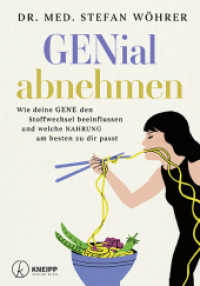- ホーム
- > 洋書
- > 英文書
- > Science / Mathematics
基本説明
Details issues in wireless voice communications and treats compression, channel coding and wireless transmission as a joint subject.
Full Description
Voice communications remains the most important facet of mobile radio services, which may be delivered over conventional fixed links, the Internet or wireless channels. This all-encompassing volume reports on the entire 50-year history of voice compression, on recent audio compression techniques and the protection as well as transmission of these signals in hostile wireless propagation environments. Audio and Voice Compression for Wireless and Wireline Communications, Second Edition is divided into four parts with Part I covering the basics, while Part II outlines the design of analysis-by-synthesis coding, including a 100-page chapter on virtually all existing standardised speech codecs. The focus of Part III is on wideband and audio coding as well as transmission. Finally, Part IV concludes the book with a range of very low rate encoding techniques, scanning a range of research-oriented topics.
Fully updated and revised second edition of "Voice Compression and Communications", expanded to cover Audio features
Includes two new chapters, on narrowband and wideband AMR coding, and MPEG audio coding
Addresses the new developments in the field of wideband speech and audio compression
Covers compression, error resilience and error correction coding, as well as transmission aspects, including cutting-edge turbo transceivers
Presents both the historic and current view of speech compression and communications.
Covering fundamental concepts in a non-mathematical way before moving to detailed discussions of theoretical principles, future concepts and solutions to various specific wireless voice communication problems, this book will appeal to both advanced readers and those with a background knowledge of signal processing and communications.
Contents
About the Authors xxi
Other Wiley and IEEE Press Books on Related Topics xxiii
Preface and Motivation xxv
Acknowledgements xxxv
I Speech Signals and Waveform Coding 1
1 Speech Signals and an Introduction to Speech Coding 3
1.1 Motivation of Speech Compression 3
1.2 Basic Characterisation of Speech Signals 4
1.3 Classification of Speech Codecs 8
1.4 Waveform Coding 11
1.5 Chapter Summary 28
2 Predictive Coding 29
2.1 Forward-Predictive Coding 29
2.2 DPCMCodec Schematic 30
2.3 Predictor Design 31
2.4 Adaptive One-word-memory Quantisation 39
2.5 DPCM Performance 40
2.6 Backward-adaptive Prediction 42
2.7 The 32 kbps G.721 ADPCM Codec 47
2.8 Subjective and Objective Speech Quality 53
2.9 Variable-rateG.726andEmbeddedG.727ADPC54
2.10 Rate-distortion in Predictive Coding 62
2.11 Chapter Summary 67
II Analysis-by-Synthesis Coding 69
3 Analysis-by-Synthesis Principles 71
3.1 Motivation 71
3.2 Analysis-by-Synthesis Codec Structure 72
3.3 The Short-term Synthesis Filter 73
3.4 Long-term Prediction 76
3.5 Excitation Models 85
3.6 Adaptive Short-term and Long-term Post-Filtering 88
3.7 Lattice-based Linear Prediction 90
3.8 Chapter Summary 97
4 Speech Spectral Quantisation 99
4.1 Log-area Ratios 99
4.2 Line Spectral Frequencies 103
4.3 Vector Quantisation of Spectral Parameters 115
4.4 Spectral Quantisers for Wideband Speech Coding 123
4.5 Chapter Summary 138
5 Regular Pulse Excited Coding 139
5.1 Theoretical Background 139
5.2 The 13 kbps RPE-LTP GSM Speech Encoder 146
5.3 The 13 kbps RPE-LTP GSM Speech Decoder 151
5.4 Bit-sensitivity of the 13 kbps GSM RPE-LTP Codec 153
5.5 Application Example: A Tool-box Based Speech Transceiver 154
5.6 Chapter Summary 157
6 Forward-Adaptive Code Excited Linear Prediction 159
6.1 Background 159
6.2 The Original CELP Approach 160
6.3 Fixed Codebook Search 163
6.4 CELP Excitation Models 165
6.5 Optimisation of the CELP Codec Parameters 174
6.6 The Error Sensitivity of CELP Codecs 192
6.7 Application Example: A Dual-mode 3.1 kBd Speech Transceiver 204
6.8 Multi-slot PRMA Transceiver 218
6.9 Chapter Summary 223
7 Standard Speech Codecs 225
7.1 Background 225
7.2 The US DoD FS-1016 4.8 kbps CELP Codec 225
7.3 The 7.95 kbps Pan-American Speech Codec - Known as IS-54 DAMPS Codec 231
7.4 The 6.7 kbps Japanese Digital Cellular System's Speech Codec 235
7.5 The Qualcomm Variable Rate CELPCodec 237
7.6 Japanese Half-rate Speech Codec 245
7.7 The Half-rate GSM Speech Codec 253
7.8 The 8 kbps G.729 Codec 257
7.9 The Reduced Complexity G.729 Annex A Codec 278
7.10 The 12.2 kbps Enhanced Full-rate GSM Speech Codec 282
7.11 The Enhanced Full-rate 7.4 kbps IS-136 Speech Codec 287
7.12 The ITU G.723.1 Dual-rate Codec 292
7.13 Advanced Multirate JD-CDMA Transceiver 302
7.14 Chapter Summary 327
8 Backward-adaptive Code Excited Linear Prediction 331
8.1 Introduction 331
8.2 Motivation and Background 331
8.3 Backward-adaptiveG728CodecSchematic 334
8.4 Backward-adaptiveG728CodingAlgorithm 336
8.5 Reduced-rate G728-like Codec: Variable-length Excitation Vector 351
8.6 The Effects of Long-term Prediction 354
8.7 Closed-loop Codebook Training 359
8.8 Reduced-rate G728-like Codec: Constant-length Excitation Vector 364
8.9 Programmable-rate 8-4 kbps Low-delay CELP Codecs 365
8.10 Backward-adaptive Error Sensitivity Issues 381
8.11 A Low-delay Multimode Speech Transceiver 388
8.12 Chapter Summary 392
III Wideband Speech, MPEG-4 Audio and Their Transmission 393
9 Wideband Speech Coding 395
9.1 Sub-band-ADPCM Wideband Coding at 64 kbps 395
9.2 Wideband Transform-coding at 32 kbps 413
9.3 Sub-band-split Wideband CELPCodecs 416
9.4 Fullband Wideband A CELPCoding 420
9.5 A Turbo-coded Burst-by-burst Adaptive Wideband Speech Transceiver 425
9.6 Turbo-detected Unequal Error Protection Irregular Convolutional Coded AMR-WB Transceivers 442
9.7 The AMR-WB+AudioCodec 454
9.8 Chapter Summary 466
10 MPEG-4 Audio Compression and Transmission 469
10.1 OverviewofMPEG-4Audio 469
10.2 General Audio Coding 471
10.3 Speech Coding in MPEG-4 Audio 495
10.4 MPEG-4CodecPerformance 503
10.5 MPEG-4 Space-time Block Coded OFDM Audio Transceiver 505
10.6 Turbo-detected Space-time Trellis Coded MPEG-4 Audio Transceivers 516
10.7 Turbo-detected Space-time Trellis Coded MPEG-4 Versus AMR-WB Speech Transceivers 525
10.8 Chapter Summary 534
IV Very Low-rate Coding and Transmission 537
11 Overview of Low-rate Speech Coding 539
11.1 Low-bitrate Speech Coding 539
11.2 Linear Predictive Coding Model 553
11.3 Speech Quality Measurements 557
11.4 Speech Database 560
11.5 Chapter Summary 563
12 Linear Predictive Vocoder 565
12.1 Overview of a Linear Predictive Vocoder 565
12.2 Line Spectrum Frequencies Quantisation 566
12.3 Pitch Detection 571
12.4 Unvoiced Frames 583
12.5 Voiced Frames 584
12.6 Adaptive Postfilter 585
12.7 Pulse Dispersion Filter 588
12.8 Results for Linear Predictive Vocoder 592
12.9 Chapter Summary 597
13 Wavelets and Pitch Detection 599
13.1 Conceptual Introduction to Wavelets 599
13.2 Introduction to Wavelet Mathematics 602
13.3 Preprocessing the Wavelet Transform Signal 607
13.4 Voiced-unvoiced Decision 610
13.5 Wavelet-based Pitch Detector 612
13.6 Chapter Summary 619
14 Zinc Function Excitation 621
14.1 Introduction 621
14.2 Overview of Prototype Waveform Interpolation Zinc Function Excitation 622
14.3 Zinc Function Modelling 627
14.4 Pitch Detection 631
14.5 Voiced Speech 635
14.6 Excitation Interpolation Between Prototype Segments 639
14.7 Unvoiced Speech 645
14.8 Adaptive Postfilter 645
14.9 Results for Single Zinc Function Excitation 646
14.10 Error Sensitivity of the 1.9 kbps PWI-ZFE Coder 649
14.11 Multiple Zinc Function Excitation 654
14.12 A Sixth-rate, 3.8 kbps GSM-like Speech Transceiver 661
14.13 Chapter Summary 665
15 Mixed-multiband Excitation 667
15.1 Introduction 667
15.2 Overview of Mixed-multiband Excitation 668
15.3 Finite Impulse Response Filter 671
15.4 Mixed-multiband Excitation Encoder 673
15.5 Mixed-multiband Excitation Decoder 676
15.6 Performance of the Mixed-multiband Excitation Coder 680
15.7 A Higher Rate 3.85 kbps Mixed-multiband Excitation Scheme 686
15.8 A 2.35 kbps Joint-detection-based CDMA Speech Transceiver 691
15.9 Chapter Summary 699
16 Sinusoidal Transform Coding Below 4 kbps 701
16.1 Introduction 701
16.2 Sinusoidal Analysis of Speech Signals 702
16.3 Sinusoidal Synthesis of Speech Signals 704
16.4 Low-bitrate Sinusoidal Coders 705
16.5 Incorporating Prototype Waveform Interpolation 709
16.6 Encoding the Sinusoidal Frequency Component 710
16.7 Determining the Excitation Components 712
16.8 Quantising the Excitation Parameters 720
16.9 Sinusoidal Transform Decoder 728
16.10 Speech Coder Performance 730
16.11 Chapter Summary 736
17 Conclusions on Low-rate Coding 737
17.1 Summary 737
17.2 Listening Tests 738
17.3 Summary of Very-low-rate Coding 739
17.4 Further Research 741
18 Comparison of Speech Codecs and Transceivers 743
18.1 Background to Speech Quality Evaluation 743
18.2 Objective Speech Quality Measures 744
18.3 Subjective Measures 752
18.4 Comparison of Subjective and Objective Measures 753
18.5 Subjective Speech Quality of Various Codecs 755
18.6 Error Sensitivity Comparison of Various Codecs 757
18.7 Objective Speech Performance of Various Transceivers 757
18.8 Chapter Summary 764
19 The Voice over Internet Protocol 765
19.1 Introduction 765
19.2 Session Initiation Protocol 766
19.3 H.323Standards 774
19.4 Real-time Transport Protocol 778
19.5 Conclusion 781
A Constructing the Quadratic Spline Wavelets 783
B Zinc Function Excitation 787
C Probability Density Function for Amplitudes 793
Bibliography 797
Index 825
Author Index 834






